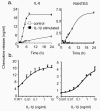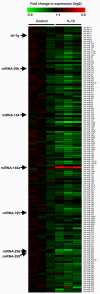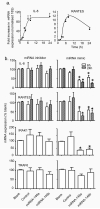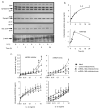Rapid changes in microRNA-146a expression negatively regulate the IL-1beta-induced inflammatory response in human lung alveolar epithelial cells
- PMID: 18390754
- PMCID: PMC2639646
- DOI: 10.4049/jimmunol.180.8.5689
Rapid changes in microRNA-146a expression negatively regulate the IL-1beta-induced inflammatory response in human lung alveolar epithelial cells
Abstract
Posttranscriptional regulation of gene expression by microRNAs (miRNAs) has been implicated in the regulation of chronic physiological and pathological responses. In this report, we demonstrate that changes in the expression of miRNAs can also regulate acute inflammatory responses in human lung alveolar epithelial cells. Thus, stimulation with IL-1beta results in a rapid time- and concentration-dependent increase in miRNA-146a and, to a lesser extent, miRNA-146b expression, although these increases were only observed at high IL-1beta concentration. Examination of miRNA function by overexpression and inhibition showed that increased miRNA-146a expression negatively regulated the release of the proinflammatory chemokines IL-8 and RANTES. Subsequent examination of the mechanism demonstrated that the action of miRNA-146a was mediated at the translational level and not through the down-regulation of proteins involved in the IL-1beta signaling pathway or chemokine transcription or secretion. Overall, these studies indicate that rapid increase in miRNA-146a expression provides a novel mechanism for the negative regulation of severe inflammation during the innate immune response.
Figures








References
-
- Braddock M, Quinn A. Targeting IL-1 in inflammatory disease: new opportunities for therapeutic intervention. Nat.Rev.Drug Discov. 2004;3:330–339. - PubMed
-
- Li X, Qin J. Modulation of Toll-interleukin 1 receptor mediated signaling. J.Mol Med. 2005;83:258–266. - PubMed
-
- Liew FY, Xu D, Brint EK, O'Neill LA. Negative regulation of toll-like receptor-mediated immune responses. Nat Rev.Immunol. 2005;5:446–458. - PubMed
-
- Ambros V. The functions of animal microRNAs. Nature. 2004;431:350–355. - PubMed
-
- He L, Hannon GJ. MicroRNAs: small RNAs with a big role in gene regulation. Nat.Rev.Genet. 2004;5:522–531. - PubMed
Publication types
MeSH terms
Substances
Grants and funding
LinkOut - more resources
Full Text Sources
Other Literature Sources

